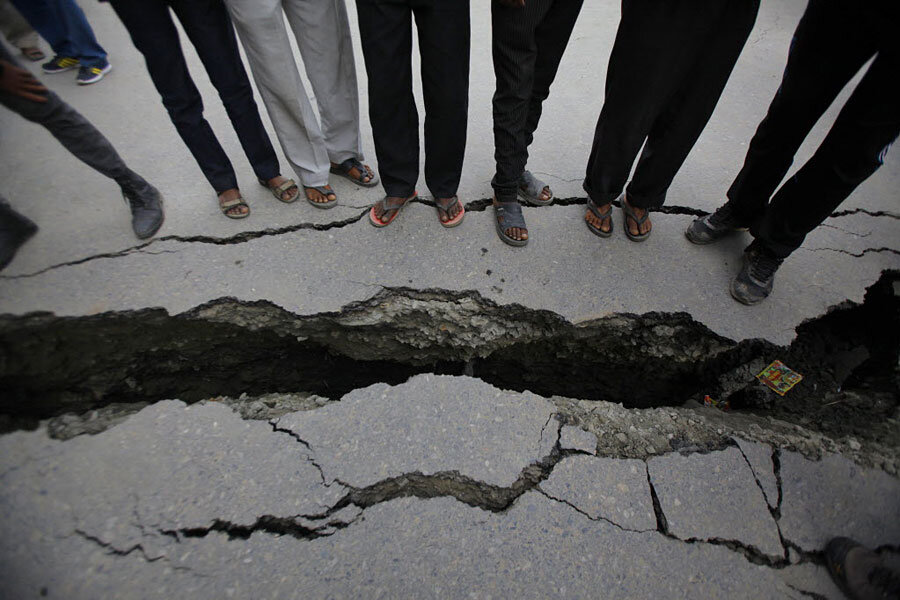Earthquakes on the rise in Texas, caused by human activity
Loading...
The ground is quaking and shaking in Texas a lot more than it was a decade ago. But don't go blaming Mother Nature.
A staggering rise in earthquakes in the Lone Star state is actually human-doing, according to a paper published Tuesday in the journal Seismological Research Letters.
Texas now experiences about 12 earthquakes of a magnitude of 3 or greater each year, up from two each year in 2008. And that lines up with an increase in use of certain techniques in the petroleum extraction industry.
The new paper reviews the history of earthquakes across Texas since the 1920s, evaluating how likely it is that activity in the petroleum industry induced the quakes. "It's been a big oil state since the 1920s," study lead author Cliff Frohlich tells The Christian Science Monitor. "I thought the Texas story was useful information for the earthquake community."
"By having this all in one place, it becomes quite obvious that we're observing something quite different from what we had been observing 10 years previously," Geoffrey Abers, director of graduate studies for geological sciences at Cornell University, who was not part of the study, tells the Monitor.
How can little humans make the big Earth shake?
"There is more than one way you can cause earthquakes," Dr. Frohlich, associate director for the Institute for Geophysics at the University of Texas, says. "The way that has been of greatest concern lately has to do with the injection of waste fluids."
In fracking, petroleum engineers pump water into the ground to fracture rock to better access oil and gas locked deep in the ground. But when some of that water comes back up out of the ground, it's quite dirty.
"You can't just dump it in the creek," Frohlich says. And "one of the cheapest and safest ways to dispose of it is to pump it back into special wells called disposal wells."
All that excess liquid becomes a sort of lubricant for faults already deep in the Earth.
It's a lot like an air hockey table, Frohlich explains. When the air is off, the puck sits firmly on the surface of the table. But when the air is on, it slips around.
Similarly, faults deep in the Earth are under pressure but stick together because rocks have high friction, he says. But "if you pump water into a fault and there's stress on it, the fault will slip."
"The injection isn't causing the stress that's causing the earthquakes, but it's relieving stress that's already there underground."
Another way humans can induce earthquakes is by extracting a lot of oil and gas quickly. "There are some earthquakes that, when you look at the data they appear to be in oil and gas fields where they've just been producing a lot of stuff," Frohlich says. "You can imagine that when you pull enough stuff out of the ground, there's a settling of layers above causing a fault to slip."
But, "Unquestionably, the biggest change in the petroleum industry that took place around 2008 has been a lot more fluid injection in places like Oklahoma and Texas than prior to that," he says. And these other states have seen their fair share of increasing human-induced quakes, too.
Human-induced earthquakes didn't start around 2008. Frohlich's review finds that human activity has been triggering earthquakes for more than 90 years.
"Texas earthquakes associated with petroleum operations and here categorized as induced have occurred since 1925," Frohlich and his colleagues write in the new paper. But with few or no seismometers installed until more recent years, little data was available to link the petroleum industry to earthquakes.
Last year Texas officials launched a $4.47-million initiative, called the TexNet Seismic Monitoring Program, to install at least 22 new seismometers across the state, adding to the existing 16. This expanded installation will monitor quakes, particularly focusing on regions where they might be human induced.
"I thought it was an excellent time for a review," Frohlich says, "What do we know about earthquakes prior to TexNet and then there'll be what do we know after."
But with less data, particularly for the earlier years, Frohlich had to devise a way to evaluate how likely a quake was caused by human activity with what data is available. The test he and his colleagues came up with consists of five questions, which they describe in the paper:
- Do the earthquakes occur only after potentially influential human activities begin?
- Are the earthquakes and human activities close enough so that a causal relationship is plausible?
- Is there evidence from the pattern of felt reports, surficial features, or credible hypocentral locations that is consistent with a relatively shallow depth and a possible causal relationship?
- Near the epicenter, are there known faults, either as mapped or as inferred from linear groupings of epicenters, that might support an earthquake, or enhance movement of fluids?
- Have credible scientists investigated these events and concluded a human cause is plausible?
By scoring the answers to these questions, the scientists are able to categorize the quakes as "almost certainly induced," "probably induced," "possibly induced," or "tectonic." And it doesn't look good.
"The test is useful, absent of any other structure, but I don't think it's a replacement for much more careful and focused analysis of any of these individual populations of earthquakes," Dr. Abers says. But Frohlich is hopeful that TexNet will help provide more precise data for such analysis.
Still, says Lorraine Wolf, a geologist and director of undergraduate research at Auburn University who was not part of this study, "That's really the first step toward taking any action, deciding whether this is something we can't do anything about, it's a naturally occurring phenomenon, or whether this is something that maybe needs some addressing and policy."









